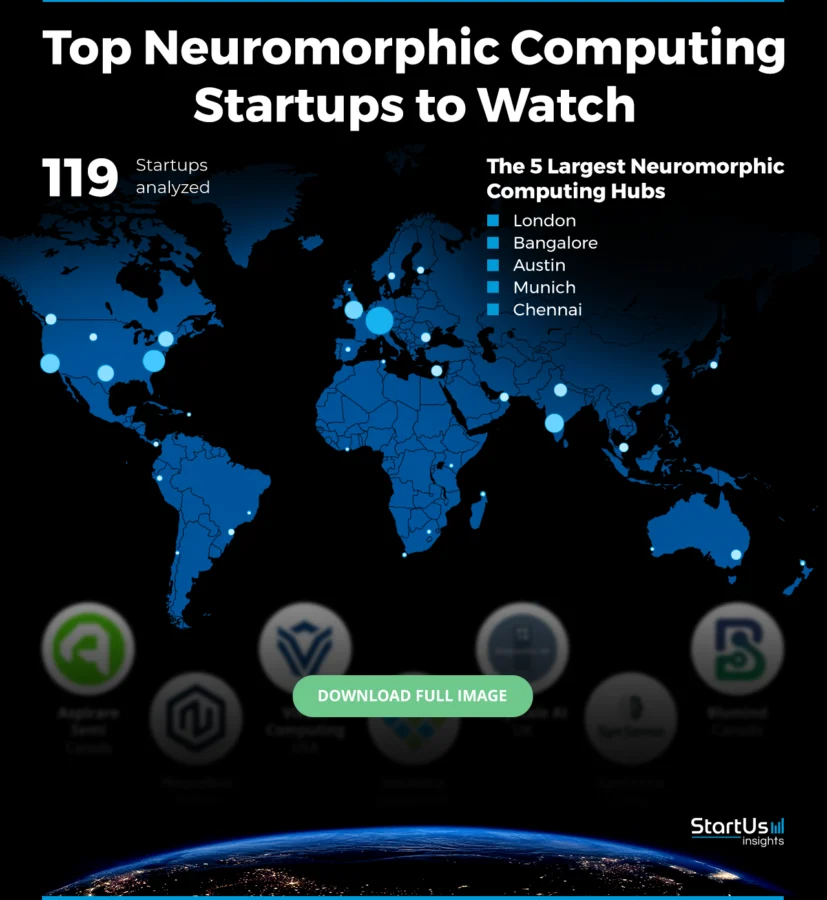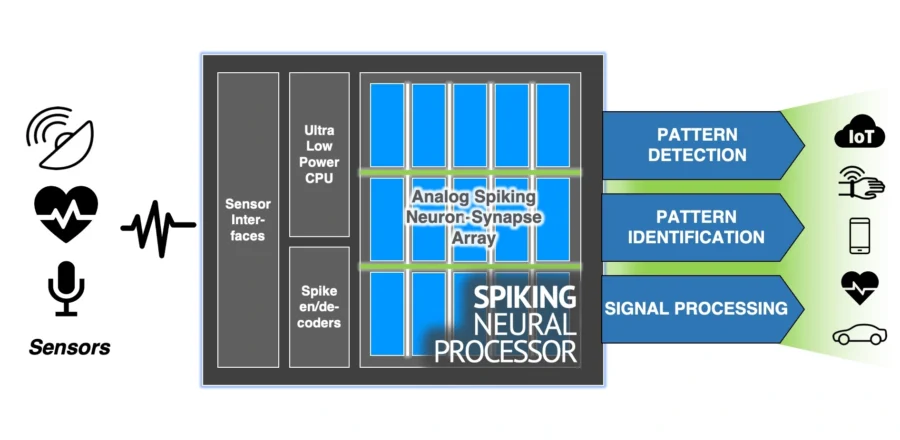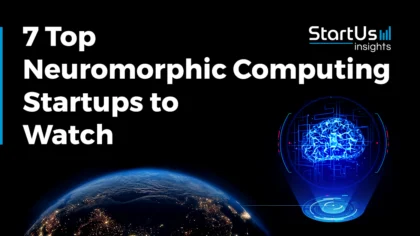Accelerate Productivity in 2025
Reignite Growth Despite the Global Slowdown
Executive Summary: Which are the Top 7 Neuromorphic Computing Startups to Watch?
- Aspirare Semi (Canada) – builds analog AI accelerators for sustainable computing to offer energy-efficient hardware solutions for AI workloads across data centers, edge devices, and IoT environments.
- Vivum Computing (USA) – makes biologically-inspired dynamic neural models using spiking networks and FPGAs to deliver real-time autonomous intelligence for uncrewed systems and edge applications.
- Grayscale AI (UK) – creates neuromorphic-powered autonomous robots capable of pattern recognition and adaptive decision-making in dynamic settings to support logistics, security, and emergency response.
- Blumind (Canada) – delivers analog AI chips for low-power, always-on tasks such as voice detection and sensor analysis.
- Neurobus (France) – provides neuromorphic processors and event-based vision systems for satellite communications and space exploration.
- Innatera (Netherlands) – produces ultra-low-power spiking neural processors for sensor devices.
- SynSense (China) – offers high-speed neuromorphic chips that integrate sensing and computation to deliver ultra-low-latency AI solutions for bio-signals, smart cameras, and auditory systems.
Global Startup Heat Map highlights Emerging Neuromorphic Computing Startups to Watch
Through the Big Data & Artificial Intelligence (AI)-powered StartUs Insights Discovery Platform, covering over 7M+ startups, 20K+ technology trends plus 150M+ patents, news articles & market reports, we identified 110+ neuromorphic computing startups.
The Global Startup Heat Map below highlights the top 7 neuromorphic computing startups you should watch in 2026 as well as the geo-distribution of 110+ startups & scaleups we analyzed for this research.
According to our data, we observe high startup activity in the United States, India, and the United Kingdom. The top 5 Neuromorphic Computing Startup Hubs are in London, Bangalore, Austin, Munich, and Chennai.

Meet the Top Neuromorphic Computing Startups to Watch in 2026
We hand-picked startups to showcase in this report by filtering for their technology, founding year, location, funding, and other metrics. These emerging neuromorphic computing startups work on solutions ranging from analog computing and fabless chip design to ultra-low-power processors and space applications.
1. Aspirare Semi
- Founding Year: 2023
- Location: Ottawa, Canada
- Use for: Sustainable Computing
Aspirare Semi creates analog computing hardware to enhance energy efficiency and performance for AI workloads, leveraging neuromorphic computing principles.
The startup offers AI accelerators like Aspirare Semi Gen 1, Aspirare Semi Gen 2, and Aspirare Semi Edge. It delivers high performance with reduced energy consumption for data centers, edge devices, and IoT.
Its technology utilizes analog compute cores by managing data through continuous signals, leading to quicker and more efficient AI computations. These analog cores are embedded in AI accelerators and are compatible with popular machine learning frameworks. This compatibility facilitates deployment across various AI applications.
Aspirare Semi offers high-performance computing platforms for data-intensive environments such as data centers and edge computing, focusing on sustainable AI advancements.
2. Vivum Computing
- Founding Year: 2023
- Location: San Francisco, CA, USA
- Use for: Biological Intelligence
Vivum Computing builds a neuromorphic computing platform that enables autonomous systems to mimic biological intelligence through dynamic neural models. It applies spiking neural networks and brain-inspired architectures using Liquid Time-Constant Networks, Continuous Time Recurrent Neural Networks, and Ordinary Differential Equations. These techniques support real-time, context-aware decision-making.
The startup uses evolutionary algorithms enhanced by FPGAs to create task-specific AI models. Further, it adopts natural selection optimization. Its models update knowledge, interpret environmental input, and manage temporal data with limited memory.
Vivum AI integrates its evolved neural networks into various hardware platforms, including microcontrollers and FPGAs. This approach allows for maintaining performance within strict size, weight, and power limits.
Moreover, its solutions offer energy-efficient, interpretable autonomy for robotics, uncrewed vehicles, and edge systems. These capabilities support operations in demanding environments.
3. Grayscale AI
- Founding Year: 2020
- Location: London, UK
- Use for: Robotic Automation
Grayscale AI creates fully autonomous robots driven by neuromorphic AI to advance robotics with brain-inspired computation. The robots utilize neural processing units that replicate human brain activity to analyze sensory data and make decisions instantaneously. This architecture allows navigation in dynamic environments, recognizes patterns, and adapts to new challenges autonomously.
Grayscale AI incorporates these functionalities into applications such as warehouse automation, surveillance, and disaster response to ensure reliability and efficiency in critical situations. The startup delivers robotic systems that merge adaptability, precision, and energy efficiency by leveraging the capabilities of neuromorphic computing to provide solutions for complex operational requirements.
4. Blumind
- Founding Year: 2020
- Location: Ottawa, Canada
- Use for: Energy-efficient Analog Computing
- Funding: Raised CAD 20M in Series A
Blumind provides analog AI computing solutions for real-time and always-on applications. Its technology directly processes continuous data streams in analog format to reduce power consumption while maintaining processing accuracy. This aids applications like audio keyword detection, visual recognition, and time-series data analysis which makes it suitable for devices requiring constant awareness and responsiveness.
Blumind’s hardware functions on a low-power basis which allows for advanced features in limited environments such as IoT devices, wearable technology, and smart home systems. The startup drives AI innovation by providing industries with sustainable tools that improve everyday technology with a focus on energy-efficient analog computing.
5. Neurobus
- Founding Year: 2023
- Location: Paris, France
- Use for: Satellite Communications
Neurobus creates neuromorphic computing solutions for space applications. Its technology imitates the architecture of biological neural networks to enable effective data processing and decision-making in extreme conditions.
The startup’s processors and event-based cameras meet the demands of space environments to deliver high performance with minimal power. Neurobus solutions augment satellite communications, refine image analysis, and facilitate autonomous operations in space exploration.
The startup handles latency, bandwidth, and energy issues in extraterrestrial applications by applying neuromorphic principles to space technologies. This results in adaptive and resilient systems that advance space missions and technology.
6. Innatera
- Founding Year: 2018
- Location: Rijswijk, Netherlands
- Use for: High-performance Pattern Recognition
Innatera produces ultra-low-power spiking neural processors to equip sensor devices with real-time pattern recognition capabilities. These processors leverage neuromorphic computing to mimic the brain’s inherent spike-based communication which allows instantaneous data analysis at the sensor edge.

This architecture enables applications such as health monitoring, environmental sensing, and autonomous navigation while functioning with a smaller portion of the energy. This technology enables devices to provide intelligent functionalities in environments with limited power supply. This advances edge AI for industries that require portable, high-performance solutions.
7. SynSense
- Founding Year: 2017
- Location: Ningbo, China
- Use for: Ultra-low-latency Neuromorphic Solutions
SynSense develops high-performance neuromorphic processors that combine digital and mixed-signal designs to enable efficient AI processing. Its chips integrate sensing and computing to facilitate real-time data processing with minimal latency and battery consumption. This technique is beneficial in domains where speed and accuracy are important, such as bio-signal analysis, smart cameras, and auditory systems.
SynSense AG offers strong-edge AI solutions that advance a range of industries, from smart cities to healthcare by directly integrating intelligence into hardware. The processors focus on accuracy and energy efficiency while providing scalable and adaptive performance.
Discover All Emerging Neuromorphic Computing Startups
The 7 neuromorphic computing startups showcased in this report are only a small sample of all startups we identified through our data-driven startup scouting approach. Download our free Industry Innovation Reports for a broad overview of the industry or get in touch for quick & exhaustive research on the latest technologies & emerging solutions that will impact your company in 2026!









